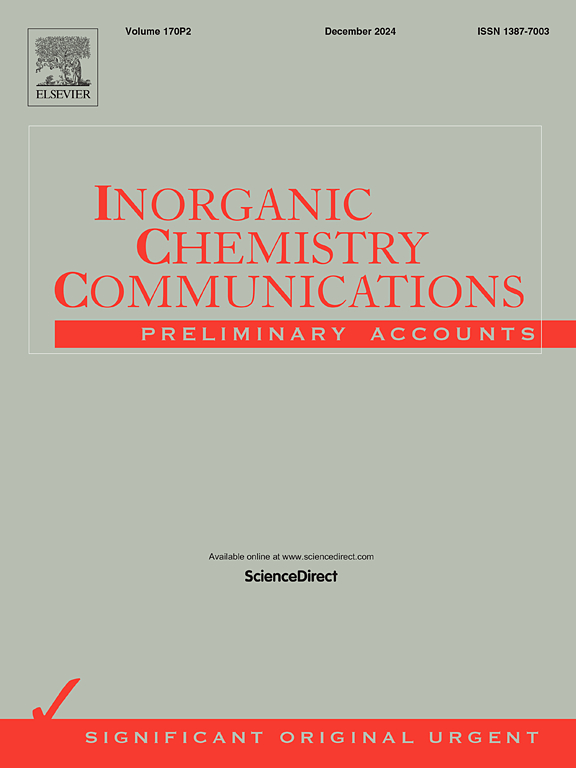Construction of AuNCs@MOF and lead ions metabolic analysis in rat serum
IF 4.4
3区 化学
Q1 CHEMISTRY, INORGANIC & NUCLEAR
引用次数: 0
Abstract
Gold nanoclusters (AuNCs) with stable fluorescence and excellent biocompatibility are promising nanomaterials in biomedical fields. However, a significant challenge is the insufficient quantum yield (QY) of AuNCs in sensing. Herein, the AuNCs were confined into a metal–organic framework (MOF) to maintain their aggregation and restrict the rotation of their ligands. A fluorescence analysis method based on AuNCs and MOF composite materials (AuNCs@UiO-66-NH2) was established for the highly sensitive detection of lead ions. The MOF-confined AuNCs had decreased energy consumption and an improved QY from 2.38 % to 7.55 %. The fluorescent probes demonstrated a strong linear correlation with lead ions in the 25.0 to 1000.0 μM range. The AuNCs@UiO-66-NH2 was successfully used as a fluorescent probe for the metabolic analysis of lead ions in rat serum with satisfactory spiking recoveries of 91.20–104.37 %. The results demonstrated the excellent fluorescence performance of AuNCs@UiO-66-NH2 and its great potential as a sensing probe for biological and clinical applications.

AuNCs@MOF构建及大鼠血清铅离子代谢分析
金纳米团簇具有稳定的荧光特性和良好的生物相容性,是一种具有广阔应用前景的纳米材料。然而,传感领域的一个重大挑战是aunc的量子产率(QY)不足。在此,aunc被限制在金属有机框架(MOF)中,以保持其聚集并限制其配体的旋转。建立了一种基于AuNCs和MOF复合材料(AuNCs@UiO-66-NH2)的荧光分析方法,用于高灵敏度检测铅离子。mof限制的AuNCs降低了能耗,并将QY从2.38 %提高到7.55 %。荧光探针在25.0 ~ 1000.0 μM范围内与铅离子表现出很强的线性相关性。AuNCs@UiO-66-NH2成功地作为荧光探针用于大鼠血清中铅离子的代谢分析,其峰值回收率为91.20 ~ 104.37 %。结果表明AuNCs@UiO-66-NH2具有优异的荧光性能,具有作为生物和临床传感探针的巨大潜力。
本文章由计算机程序翻译,如有差异,请以英文原文为准。
求助全文
约1分钟内获得全文
求助全文
来源期刊

Inorganic Chemistry Communications
化学-无机化学与核化学
CiteScore
5.50
自引率
7.90%
发文量
1013
审稿时长
53 days
期刊介绍:
Launched in January 1998, Inorganic Chemistry Communications is an international journal dedicated to the rapid publication of short communications in the major areas of inorganic, organometallic and supramolecular chemistry. Topics include synthetic and reaction chemistry, kinetics and mechanisms of reactions, bioinorganic chemistry, photochemistry and the use of metal and organometallic compounds in stoichiometric and catalytic synthesis or organic compounds.
 求助内容:
求助内容: 应助结果提醒方式:
应助结果提醒方式:


